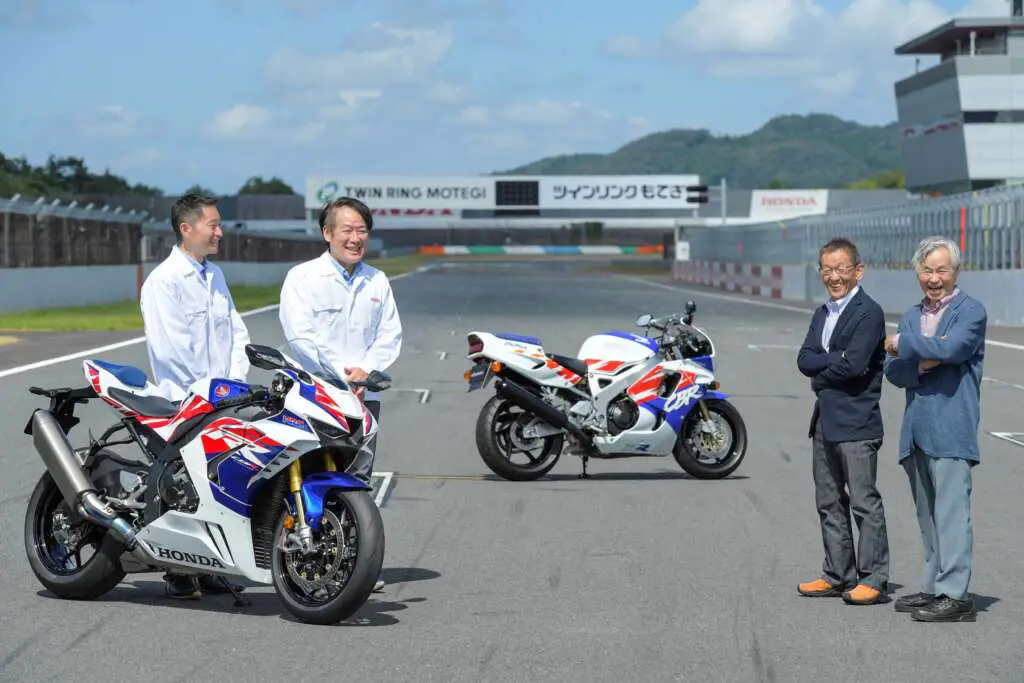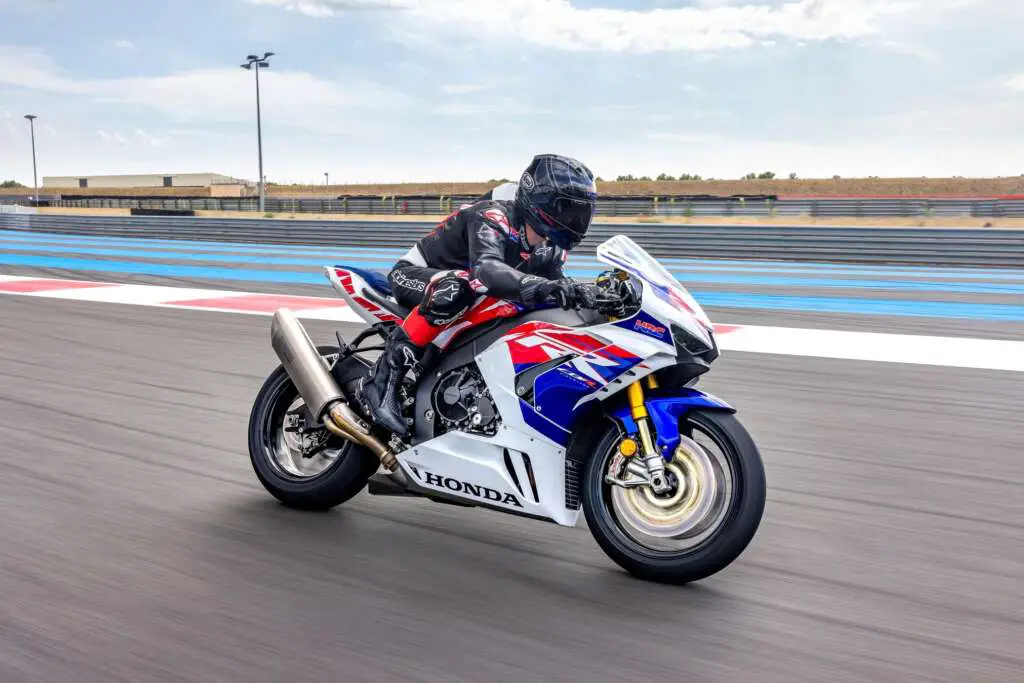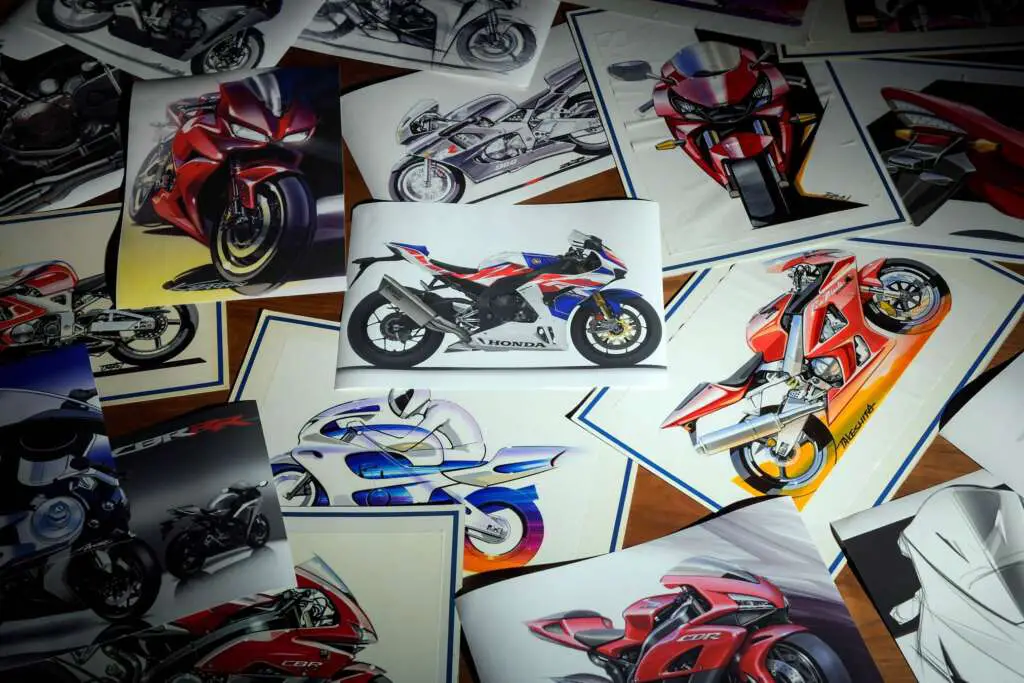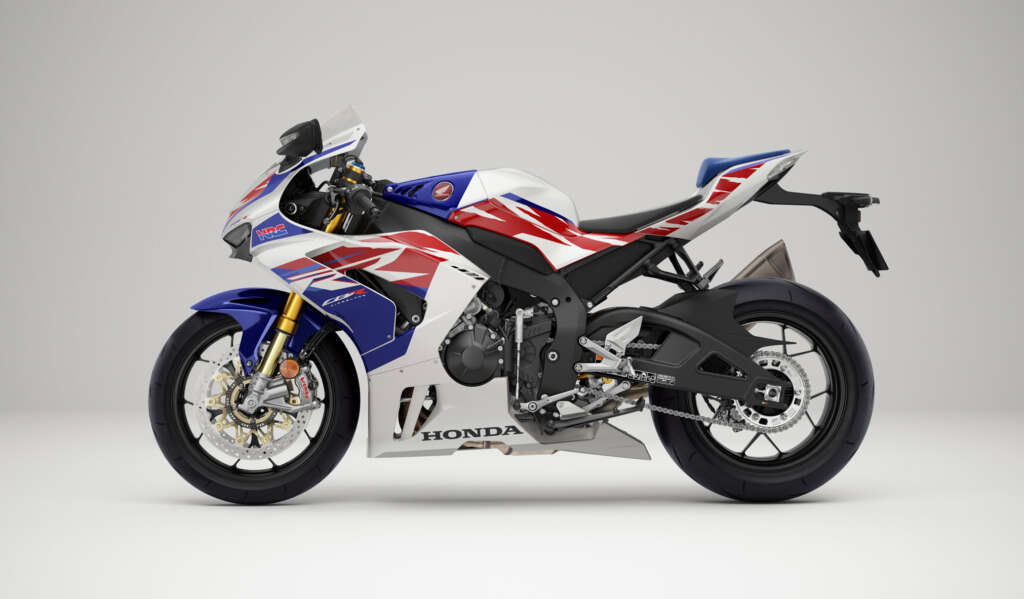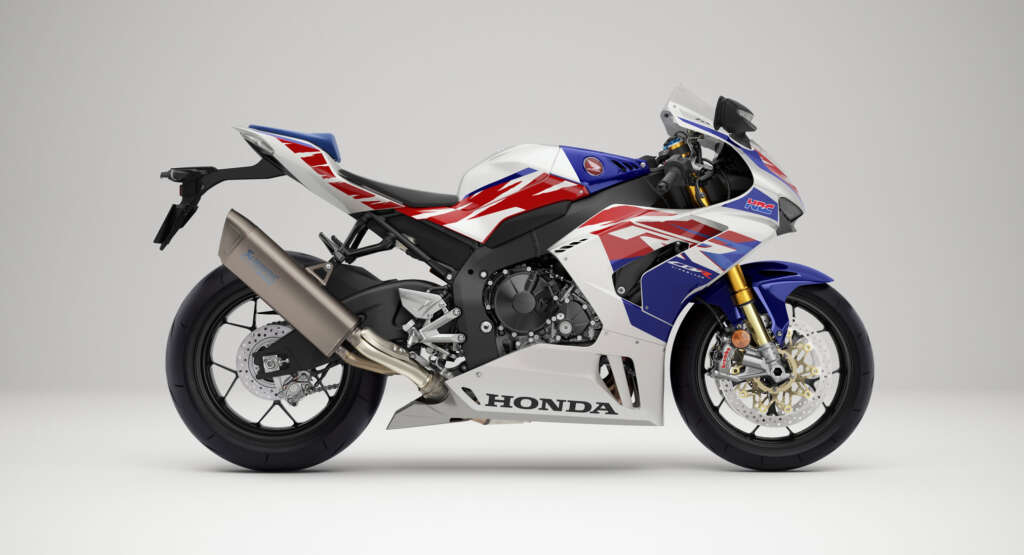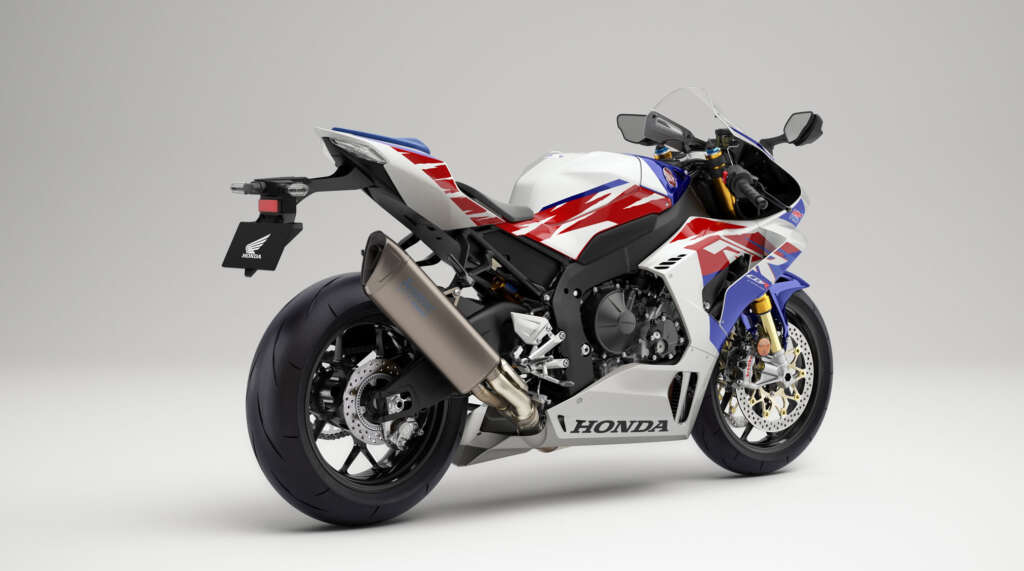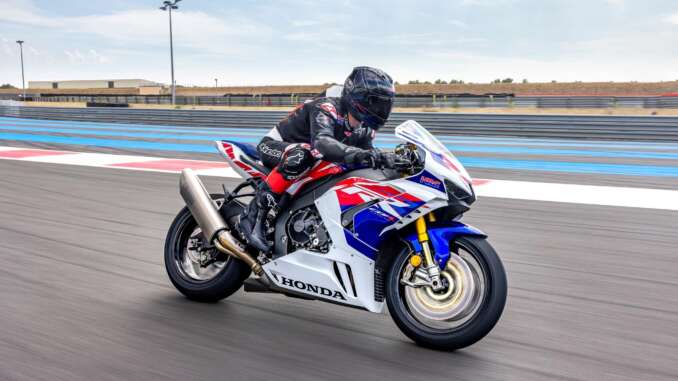
2022 Honda CBR1000RR-R Fireblade SP 30th Anniversary: OUR ETERNAL FLAME.
Introducing the 2022 Honda CBR1000RR-R Fireblade SP 30th Anniversary…
To celebrate the original, ground-breaking Fireblade of 1992, a Limited Edition ‘Tricolour’ paint scheme will be available for 22YM, designed by Mr. Hiroaki Tsukui, who was also responsible for the original 1992 colour design. Instantly recognisable, all the details are present and correct, with the ultra-modern feel of the 2020 stripe layout merged with ‘brushstroke’ style elements that pay clear homage to the seminal original. The blue rear seat continues the theme.
The flame that burns brightest is the will to challenge, and from that burning passion we created something quite extraordinary in 1992. Something that not only created a new sport bike category, but also changed sport motorcycles forever. Now, in its 30th Anniversary year, the very name ‘Fireblade’ still sets hearts racing.
SHARP AS EVER
Taking the colours and graphics of the original CBR900RR Fireblade, our CBR1000RR-R Fireblade SP 30th Anniversary pays homage to its unique heritage with a nostalgic nod to its sporting past.
Other further details set it apart. On start-up, there’s a ‘Ring of Fire’ screen animation as the display loads. The unique serial number for each bike is laser-engraved on the top yoke and 30th Anniversary logos – on the fuel tank cover, the Smart Key fob, and laser-engraved on the Akrapovič muffler – place a subtle extra special stamp, marking the CBR1000RR-R Fireblade SP 30th Anniversary’s own place in Honda history.
Be in no doubt. The CBR1000RR-R Fireblade SP is built for the track. This is where it belongs. It starts in the same pit lane as the standard Fireblade, but full Öhlins Smart Electronic Control (S-EC) suspension, Brembo master cylinder, brake lever, front and rear calipers and standard-fit quick shifter set it apart. Armed with class-leading 160kW peak power, the semi-cam gear engine has been upgraded with low- to mid-range acceleration boost and refined HSTC traction management. And while it is fully road legal, with lights, indicators and Smart Key, the Fireblade SP defines the ultimate racing motorcycle. One ready to overload adrenaline through every turn.
The CBR1000RR-R Fireblade SP was a brand-new motorcycle in 2020, and built with an unwavering focus on circuit riding. For 2022 development of its inline four-cylinder engine, while retaining peak output of 160kW @ 14,500rpm, has centred on mid-corner acceleration and drive: intake ports, airbox, airbox funnels and exhaust mid-section have all been revised to deliver extra mid-range. The final drive sprocket goes up 3 teeth, to 43, for stronger acceleration through each ratio and quick shifter performance has been upgraded. Honda Selectable Torque Control (HSTC) has also been optimised – with feedback from HRC’s riders – for refined rear tyre traction management, and throttle feel improved even further. The rest of the chassis – comprising aluminium diamond-style frame, RC213V-S-style swingarm, six-axis Inertial Measurement Unit (IMU) and 3-level Honda Electronic Steering Damper (HESD) – is unchanged. Full, race-quality suspension is provided by Öhlins Smart Electronic Control (S-EC) and OBTi user interface, with braking front and rear by Brembo. The bodywork and riding position maintain an uncompromising focus on aerodynamic performance, and the fairing features MotoGP-derived winglets to generate downforce. A full-colour TFT screen offers intuitive control of riding modes and adjustment of Power, Engine Brake, HSTC, Wheelie Control, Start Mode and ABS modes. A Smart Key is the finishing touch.
For 2022 both the existing paint options now feature gold wheels, and they are joined by one very special new choice. That is, the limited edition Fireblade SP 30Th Anniversary, which pays diligent homage to the original ’92 Fireblade, the bike that started it all 30 years ago.
Since its original 1992 introduction Honda’s iconic Fireblade has evolved into an incredible 1000cc sports motorcycle. And it’s also been the base of a competitive race machine, on short circuits around the world and the roads of the Isle of Man TT.
But time – and competition – always races on and in 2020 Honda drew the line under where the CBR1000RR Fireblade had been, and looked forward to where it was going. And, as a result, two brand-new motorcycles – the CBR1000RR-R Fireblade* and CBR1000RR-R Fireblade SP – were created with heavy involvement from Honda Racing Corporation to carry the legend forward.
Leaning heavily on the engine and chassis technology of the RC213V-S ‘street-legal MotoGP machine’, with aerodynamics drawn from the RC213V MotoGP bike, the new Fireblade was designed from the ground up – in terms of engine, handling and aerodynamics – for pure, outright track performance.
2022 is an important anniversary for Honda, and its Fireblade, as it marks 30 years of what has proved, over time, a truly seminal sports machine. A variety of detail updates improve both corner-exit acceleration, HSTC management and throttle feel and, to mark three decades of sheer, undiluted performance, the CBR1000RR-R Fireblade SP 30th Anniversary will be available for Europe in a limited edition, instantly-recognisable and evocative paint option.
The Fireblade SP’s inline four-cylinder engine delivers 112Nm @ 12,500rpm and makes peak power of 160Kw @ 14,500rpm.
Updates for 22YM centre around upping mid-corner drive and acceleration. Firstly, the rear sprocket goes from 40 to 43 teeth, improving acceleration through the gears in the mid-range while maintaining high-rpm output.
Both airbox and intake funnels have been re-shaped to smooth flow. The intake ports have been adjusted to increase airflow velocity while exhaust flow into the catalyser (and the catalyser itself) has been optimised.
Throttle By Wire (TBW) spring load has been reduced, for improved linearity and response on opening. Using extensive feedback from racers around the world – including Honda’s HRC World SBK team – Honda Selectable Torque Control (HSTC) has been refined to offer the rider the power, grip level and feel they want, and to match the increased drive.
As before, three default riding modes cover most conditions with options to fully adjust Power, Engine Brake, Wheelie Control and HSTC. The electronics package also includes adjustable Start Mode and standard-fit, newly revised, quick shifter.
The engine uses a compact, short-stroke layout – sharing the bore and stroke of the RC213V – and features a semi-cam gear train, finger-follower rocker arms, titanium con-rods, RC213V-S internal friction reduction technologies, piston jets with check ball system and a built-in bottom bypass passage for the cylinder water jacket. A ram-air duct in the front fairing feeds directly through the headstock. The 4-2-1 exhaust downpipes are ovalized and feed a titanium Akrapovič end-can.
An aluminium diamond frame uses the rear of the engine as upper shock mount while the swingarm is based on the RC213V-S design. The rigidity balance, weight distribution and steering geometry are carefully adjusted to exploit the engine’s output, in terms of front and rear grip levels, and feel for both. A six-axis Inertial Measurement Unit (IMU) provides accurate 3D estimation of riding dynamics and provides input to manage all of the electronic systems. It also controls the rod-type 3-level Honda Electronic Steering Damper (HESD).
Öhlins Smart Electronic Control (SE-C) 43mm NPX forks and TTX36 rear shock offer race-quality suspension, with settings managed by second-generation Öhlins Object Based Tuning interface (OBTi). The front discs are worked by Brembo Stylema four-piston calipers and Brembo brake lever/master cylinder, while the ABS is adjustable for track riding.
Honda’s RC213V MotoGP machine leant some of its slippery aerodynamics to the Fireblade, including winglets to increase downforce and improve braking stability. The riding position is also very compact. A fully customisable 5-inch TFT display offers intuitive control via a four-way switch on the left handlebar. Honda’s Smart Key system adds convenience.
2022 Honda CBR1000RR-R Fireblade SP 30th Anniversary Totalmotorcycle.com Key Features
The CBR1000RR-R Fireblade SP 30th Anniversary and new ADV350 headline Honda’s 2021 EICMA line-up
- New CBR1000RR-R Fireblade, Fireblade SP and limited edition Fireblade SP 30th Anniversary mark three decades of continuous challenges
- Brand new ADV350 mid-sized scooter pairs tough X-ADV style design with premium specification list
- The NT1100 makes its show debut; offers comfort, practicality and supremely enjoyable long distance performance
- Hornet return in 2022 confirmed; 3D projection mapping gives customers a glimpse of concept direction
- New colours on show at EICMA for SH125i, X-ADV, Forza 125, Forza 350, CB650R, CBR650R, CMX500 Rebel, CMX1100 Rebel, Gold Wing and Gold Wing ‘Tour’
Following a long line of significant model announcements already this year including the Super Cub, Monkey, CB500F, CB500X, CBR500R and NT1100, Honda today reveals its full 2022 European motorcycle line-up in Milan. The line-up includes a very special, limited edition super sports flag ship, a brand new adventure scooter and a host of colour options and graphics throughout the range.
CBR1000RR-R Fireblade, Fireblade SP and Fireblade SP 30th Anniversary
Headlining Honda’s EICMA line-up is the new CBR1000RR-R Fireblade, Fireblade SP and Fireblade SP 30th Anniversary.
To celebrate the original, ground-breaking Fireblade and 30 years of continuous challenges since the introduction of that 1992 game-changer, a stunning Limited Edition 30th Anniversary version of the Fireblade SP will be available in 2022. Its tricolour paint scheme pays faithful homage to the original, with the ultra-modern feel of the 20YM stripe layout merged with ‘brushstroke’ style elements of the 1992 machine.
The Fireblade SP will also be available in two standard paint options, Grand Prix Red and Matte Pearl Morion Black, both now with gold wheels, while the Fireblade itself wears an updated Grand Prix Red paint scheme with prominent white number boards on the front fairing.
The changes are more than skin deep, with technical changes to the 160kW inline four-cylinder engine that focus on improving mid-corner acceleration and drive. The final drive sprocket also goes up 3 teeth, to 43, further boosting acceleration through each ratio. Honda Selectable Torque Control (HSTC) has been optimised for refined rear tyre traction management with input from HRC’s riders, and throttle feel even further refined.
A new material and surface finish for the Fireblade’s front Nissin brake calipers’ pistons improves braking performance and consistency in race conditions. The Fireblade SP’s Öhlins Smart Electronic Control (SE-C) and Brembo equipment continue to offer top-draw suspension and braking, alongside a newly optimised quick shifter.
As Honda celebrates 30 years of the Fireblade, another legend takes the stage: Baba-san is back.
• Short-stroke, inline four-cylinder engine produces high output at high rpm; 160Kw @ 14,500rpm with peak torque of 112Nm @ 12,500rpm
• New 43 tooth rear sprocket shortens overall gearing for improved drive and acceleration, opening up gear selection choice
• Intake ports re-shaped to increase flow; air intake funnels and airbox revised to match
• 4-2-1 exhaust ‘2’ mid-section and catalyser optimised for gas flow
• Honda Selectable Torque Control (HSTC) software upgraded for smoother traction management, with feedback from HRC’s riders
• Throttle By Wire return spring load lightened for more linear throttle delivery
• Quick Shifter updated for faster, smoother gear changes
• Three default riding modes plus options to customise Power, Engine Brake, HSTC and Wheelie control
• Start Mode standard fitment
• Aluminium frame and swingarm feature tuned rigidity balance for precise handling and feel for grip
• Bosch six-axis Inertial Measurement Unit (IMU) gives accurate calculation of dynamic behaviour and precise control
• Second-generation Öhlins Smart Electronic Control (S-EC) offers refined choice of settings. The Öhlins NPX fork features pressurised damping for outstanding bump absorption and feel
• Brembo Stylema radial-mount four-piston calipers managed by ABS with switchable SPORT/TRACK modes
• Showa’s 3-level Honda Electronic Steering Damper (HESD) controlled by IMU for stability management
• Fairing, screen and mudguard minimise frontal area and reduce drag; low fuel tank cover provides compact riding position
• Inner fairing winglets drawn from the RC213V MotoGP machine reduce wheelies under acceleration and improve braking stability
• 5-inch colour TFT screen and four-way left-hand switch offer intuitive control of riding systems
• Smart Key operation adds convenience
Ignition on
When it’s time to go, the 30th anniversary Fireblade comes to life with a “Ring of fire” as the needle sweeps from left-to-right on the instrument panel.
One of a kind
A limited number of these special Fireblades are issued with their very own individual serial number etched into the fork top yolk.
Loud and clear
Just to reaffirm its status as one of the finest motorcycles around, we have added another neat touch with a specially engraved Akrapovic muffler.
Racing lines
Sharp graphics that reflect the very first Fireblade – along with the legendary HRC logo – make the bike look fast even when it’s parked.
Badge of honour
A specially designed logo to commemorate 30 great years of outstanding performance on the track and on the road.
The personal touch
The smart key fob ignites the fire, adding a very special touch, with the latest CBR Fireblade and 30th Anniversary logos.
Ignition on
When it’s time to go, the 30th anniversary Fireblade comes to life with a “Ring of fire” as the needle sweeps from left-to-right on the instrument panel.
One of a kind
A limited number of these special Fireblades are issued with their very own individual serial number etched into the fork top yolk.
Loud and clear
Just to reaffirm its status as one of the finest motorcycles around, we have added another neat touch with a specially engraved Akrapovic muffler.
Racing lines
Sharp graphics that reflect the very first Fireblade – along with the legendary HRC logo – make the bike look fast even when it’s parked.
Badge of honour
A specially designed logo to commemorate 30 great years of outstanding performance on the track and on the road.
The personal touch
The smart key fob ignites the fire, adding a very special touch, with the latest CBR Fireblade and 30th Anniversary logos.
Honda CBR1000RR-R Fireblade SP with Brembo Brakes
Brembo Front and Rear Calipers for Race Specification Braking Performance
Biting on 330mm discs the four-piston, radial-mount Stylema calipers deliver massive stopping power. They’re operated by a Brembo brake lever/master cylinder and matched with a Brembo rear caliper.
Honda CBR1000RR-R Fireblade SP with High-Efficiency Akrapovic Titanium Muffler and New Exhaust Design
Lightweight High-Efficiency Akrapovic Titanium Muffler and New Exhaust Design
Redesigned in the mid-section, the 4-2-1 exhaust system employs oval-section downpipes for maximum gas flow and power. It feeds a compact titanium Akrapovic muffler which equally offers free-flowing output efficiency.
Honda CBR1000RR-R Fireblade SP with Faster Quick Shifter
Faster Quick Shifter Ensures Smooth, Instant Gear Changes
The standard-fit quick shifter is now quicker. It’s been through development for a shorter fuel cut time while shifting, and smoother torque pickup after shifting. All of which means more speed gained with every gear change.
Honda CBR1000RR-R Fireblade SP with high RPM
High-RPM DOHC Inline Four-Cylinder Engine with Low- to Mid-Range Performance Boost
Updates to the 1000cc engine’s inlet ports, airbox, 4-2-1 exhaust and gearing improve low- to mid-range acceleration. There’s still huge peak power on tap for your throttle hand to exploit – 160kW @ 14,500rpm. New HSTC software offers refined reaction and finer feel for traction.
Honda CBR1000RR-R Fireblade SP with HRC Ram-Air Duct
HRC Ram-Air Duct Generates Power, Winglet Structures High-Speed Stability
Aerodynamics from the RC213V MotoGP race bike include vertical winglet structures that maximise acceleration and high-speed braking stability. An HRC-designed ram-air duct feeds high-pressure air directly through the headstock for ultimate peak power.
Honda CBR1000RR-R Fireblade SP with Öhlins Smart Electronic Control
Öhlins Smart Electronic Control (S-EC) Delivers Ultimate Suspension Reaction
Semi-active Öhlins S-EC offers incredible suspension reaction. The 43mm NPX USD fork uses pressurised damping to minimise cavitation for more stable control, improved high-speed bump absorption, and feedback.
Honda CBR1000RR-R Fireblade SP with Brembo Brakes
Brembo Front and Rear Calipers for Race Specification Braking Performance
Biting on 330mm discs the four-piston, radial-mount Stylema calipers deliver massive stopping power. They’re operated by a Brembo brake lever/master cylinder and matched with a Brembo rear caliper.
Honda CBR1000RR-R Fireblade SP with High-Efficiency Akrapovic Titanium Muffler and New Exhaust Design
Lightweight High-Efficiency Akrapovic Titanium Muffler and New Exhaust Design
Redesigned in the mid-section, the 4-2-1 exhaust system employs oval-section downpipes for maximum gas flow and power. It feeds a compact titanium Akrapovic muffler which equally offers free-flowing output efficiency.
Honda CBR1000RR-R Fireblade SP with Faster Quick Shifter
Faster Quick Shifter Ensures Smooth, Instant Gear Changes
The standard-fit quick shifter is now quicker. It’s been through development for a shorter fuel cut time while shifting, and smoother torque pickup after shifting. All of which means more speed gained with every gear change.
Honda CBR1000RR-R Fireblade SP with high RPM
High-RPM DOHC Inline Four-Cylinder Engine with Low- to Mid-Range Performance Boost
Updates to the 1000cc engine’s inlet ports, airbox, 4-2-1 exhaust and gearing improve low- to mid-range acceleration. There’s still huge peak power on tap for your throttle hand to exploit – 160kW @ 14,500rpm. New HSTC software offers refined reaction and finer feel for traction.
Honda CBR1000RR-R Fireblade SP with HRC Ram-Air Duct
HRC Ram-Air Duct Generates Power, Winglet Structures High-Speed Stability
Aerodynamics from the RC213V MotoGP race bike include vertical winglet structures that maximise acceleration and high-speed braking stability. An HRC-designed ram-air duct feeds high-pressure air directly through the headstock for ultimate peak power.
Honda CBR1000RR-R Fireblade SP with Öhlins Smart Electronic Control
Öhlins Smart Electronic Control (S-EC) Delivers Ultimate Suspension Reaction
Semi-active Öhlins S-EC offers incredible suspension reaction. The 43mm NPX USD fork uses pressurised damping to minimise cavitation for more stable control, improved high-speed bump absorption, and feedback.
CHASING PERFECTION
The perfect lap. That’s the impossible goal. And there are two involved in this pursuit; you and your bike. You’ve done the practice, clipped every apex and linked up corners. You’re at home on this track. So is your Fireblade SP. The engine’s delivering the performance you need, where you need it, while the chassis and electronics are generating huge grip. The speed and the handling confidence the aerodynamics deliver is incredible. You and your bike, as one. It’s where you both belong.
More low- and Mid-Range For Harder Corner Exit Acceleration
Producing 160kW at a stunning 14,500rpm the inline four-cylinder, semi-cam gear train engine shares the same bore and stroke, and friction-reducing technology as the RC213V race bike – with titanium con-rods, as well as forged aluminium pistons. New updates include a 43-tooth rear sprocket and optimisation of airbox funnels, inlet ports and 4-2-1 exhaust. So alongside the huge, high-rpm peak power, you now have a whole lot more low- and mid-range acceleration to drive even harder out of corners. An updated quick shifter delivers smoother, faster gear changes for even quicker lap times.
Helping You Go Faster Is What the Fireblade SP Does
You can manage every detail of your Fireblade SP’s engine performance. Three default riding modes offer base settings to work from, and via the 5-inch TFT screen, you can customise engine power, engine braking and wheelie control. To help you punch out of turns harder, we’ve used feedback from our HRC racers to update the 9-level Honda Selectable Torque Control. It’s smoother, more responsive to throttle input and makes good use of the engine’s extra low- and mid-range acceleration. To match, we’ve reduced the Throttle By Wire (TBW) return spring load to give even more linearity as you wind on the gas.
OBTi Management For the Perfect Setup
Using separated compression, rebound circuits and stepper motors to adjust damping, the Semi-active Öhlins S-EC 43mm NPX USD forks have been developed for racing use to offer precise front tyre feedback and grip. The result? Huge confidence to go for a faster lap time. The race-quality front end is matched by an Öhlins TT36 S-EC rear shock. To provide maximum control – and because conditions change very quickly on track – you can work from default Öhlins Objective Tuning Base interface (OBTi) setting with 3, instantly selectable pre-set modes to completely change your set-up allowing for reduced fuel load, tyre wear, or track conditions.
With Two-Mode ABS Control
Rigid, Brembo Stylema monobloc four-piston radial-mount brake calipers use less internal fluid volume for more immediate reaction. Operated by Brembo brake lever and master cylinder, they ensure massive, braking power. The rear Brembo brake caliper is the same design used by the RC213V. Two ABS modes give you choice of performance: SPORTS is biased toward road riding, while TRACK ups braking force for much higher track speeds. Brake force is also managed relative to lean angle while Rear Lift Control maintains forward-pitch stability – so you can concentrate on getting in, and out, of a corner faster.
2022 Honda CBR1000RR-R Fireblade SP 30th Anniversary Totalmotorcycle.com Features and Benefits
RACING DNA
Racing improves the breed, it’s in the blood, and the bloodline continues with this latest incarnation. Racing technology, derived from RC213V MotoGP machine, raced by 8-times World Champion Marc Marques, provides total control at the highest level. It’s the closest you can get to Superbikes without your own pit crew.
Engine
The Fireblade’ SPs 1000cc, inline four-cylinder semi-cam gear engine was designed with heavy input from the HRC MotoGP development program. It generates peak power of 160Kw @ 14,500rpm, with peak torque of 112Nm @ 12,500rpm. To achieve the required valve size, combustion efficiency and friction reduction to generate these numbers, the Fireblade’s engine shares the same ‘over square’ 81mm bore and 48.5mm stroke as the RC213V. Compression ratio has increased from 13.2:1 to 13.4:1.
Air is fed into the engine via a ram-air duct located at the high-surface pressure tip of the front fairing; the size of its aperture is equivalent to that of the RC213V MotoGP machine. A ribbed ‘turbulator’ to the right, left and above the duct entrance ensures maximum induction of moving air with minimal impact on handling. The draft angle of the aperture’s interior wall maintains flow under high-speed and acceleration.
To maintain stable performance across a wide speed range, pressurised air takes a straight shot through the headstock, around the steering stem and into the airbox. This smooth path is made possible by Honda’s Smart Key system and steering angle of 25°. To draw the volume of air needed the throttle bodies employ 52mm diameters.
New for 22YM, for smoother airflow on an opening throttle, the ‘dirty’ side of the air filter has been adjusted to control the direction of intake air separation and vortex generation. On the ‘clean’ side, filtered air now feeds slash-cut intake funnels, with #2 and #3 shortened by 15mm. Also, and to match, the inner diameter of the intake ports has been partially narrowed to increase airflow velocity, improving filling efficiency thus performance through the mid-range. Supplementing this change, with the same aim of improved acceleration through the gears in the mid-range, while maintaining high-rpm output, the rear sprocket goes from 40 to 43 teeth.
Mirroring the intake side, the four exhaust downpipes use an oval cross section. For 22YM, the 4-2-1 exhaust now features a redesigned ‘2’ section, feeding the catalyser (and the catalyser itself), for optimised gas flow.
Constructed from titanium, the Akrapovič-design muffler’s small physical size and light weight contribute to mass centralisation and right-side lean angle. The exhaust valve was also designed with Akrapovič to deliver both low-rpm torque and high-rpm power; a valve stopper (patent-pending) stops exhaust-gas leak when closed while also reducing noise.
The inlet valves are 32.5mm diameter, with 28.5mm exhaust; they’re operated by finger-follower rocker arms; valve angle on the intake side is 9°, reducing the surface area of the combustion chamber and improving combustion efficiency.
MotoGP technology is everywhere internally. Friction is reduced by the use of Diamond Like Carbon (DLC) on the cam lobes – just like the RC213V-S. 20YM marked the first time this process was used on a mass-produced motorcycle and sees a reduction in valve train frictional loss of 35% compared to non DLC-coated lobes.
The valve train is driven by a semi-cam gear train system. To drive such high-rpm/high-cam lift performance the chain is driven from the timing gear located on the crank shaft via the cam idle gear; this makes it shorter in length.
Forged, lightweight TI-64A Titanium (a material developed by Honda) con-rods and con-rod caps save 50% in weight compared to Chromium Molybdenum steel versions; they also employ HB 149 Chromium Molybdenum Vanadium (Cr-Mo-V, again a Honda development) steel bolts and do without fastening nuts.
To ensure durability the same configuration as the RC213V-S is applied to the sliding surfaces; the small-end bushings are made of shaved C1720-HT Beryllium copper (because of its high-rpm reliability) while the surfaces of the big-ends are treated with DLC.
The pistons are forged from A2618 aluminium (like the RC213V-S) for lightweight strength and durability. To guarantee high-rpm wear resistance the piston skirts feature an Ober coating (Teflon and Molybdenum base) and nickel-phosphorous plating for the piston-pin clip-groove.
To manage temperature the pistons use a multi-point piston jet which sprays cooling oil in multiple directions through each cycle. At low rpm – when not needed – check balls within the jets shut off the flow of oil in order to limit oil pressure loss and reduce friction.
To reduce bore distortion (and thus friction), the cylinder features a built-in bottom bypass. This system circulates cool water from the radiator into the main water jacket, while the area below uses non-cooled water. The net effect is a lower, and more even, temperature at all points across the bores.
Minimising width the engine is started by rotation of the clutch main shaft rather than the crankshaft. This design for a more compact crankshaft while double use of the primary driven gear (which itself has fewer teeth) to also transmit rotation from the starter motor saves space; the engine is short in length thanks to reduction in distance between the crankshaft, counter shaft and main shafts. The rear of the engine block also serves as upper shock mount.
Engine Electronics
The 17YM CBR1000RR was the first in-line four-cylinder engine from Honda to use Throttle by Wire (TBW). Derived and developed from the system used by the RC213V-S, it controls the throttle butterfly valve angle (relative to input from the throttle) to provide a linear delivery and puts precise throttle control – and a natural feel – in the rider’s right hand.
It’s a critical area and for 22YM, to match the increased drive, the TBW return spring load has been reduced, further enhancing the response and linearity of throttle input.
In conjunction the 9-level (plus off) Honda Selectable Torque Control (HSTC) has also been upgraded. For 20YM The CBR1000RR-R Fireblade HSTC gained slip rate control (which monitors the rate at which slip is changing based on the ratio of front/rear wheel speeds) to smoothly moderate rapid wheel spin. For 22YM the gap between the intervention timing and slip rate has been changed for much smoother, intuitive grip management, with software developed with wide-ranging, top-level feedback from around the world, including HRC’s riders.
There are three default riding modes, with options to change engine output and character. Power (P) operates through levels 1-5 with 1 giving ultimate outright power. Engine Brake (EB) manages performance on a closed throttle through levels 1-3, with 1 being the strongest engine braking; Wheelie (W) manages through levels 1-3 (plus off) with 1 giving the weakest intervention.
Wheelie Control uses information gathered by the IMU on the Fireblade SP’s pitch angle, along with front and rear wheel speed sensors to maintain torque and deal with the wheelie without sacrificing forward drive.
The Fireblade SP is also equipped with Start Mode for race starts. It limits engine rpm at 6,000, 7,000, 8,000 and 9,000rpm set-points, even with a wide-open throttle, letting the rider focus on clutch release (and lights) alone. The standard-fit quick shifter is also now quicker. It’s been through development for a shorter fuel cut time while shifting and smoother torque pickup after shifting.
Chassis
The diamond-style main frame is constructed from 2mm aluminium with an extremely accurate tuning of the rigidity balance; in manufacture, after the four main frame components are welded, the engine mounts in six locations improving machine handling. Vertical and torsional rigidity are carefully balanced against each other, with the aim of producing maximum levels of feel.
Wheelbase is set at 1,460mm, with rake and trail of 24°/102mm. Wet weight is 201kg. Weight distribution is set at 53%/47% while a high c-of-g improves side-to-side agility.
The swingarm – constructed from 18 individual thicknesses of aluminium and as used by the RC213V-S – is 622.7mm long. Like the main frame its horizontal and vertical rigidity are tuned together to generate grip and feel.
For optimum frame rigidity (and to save weight) the top mount of the Pro-Link rear shock attaches to the rear of the engine block via a bracket. This also isolates the rear wheel from the headstock, improving high-speed stability and feel for rear wheel traction.
Round, thin-wall aluminium tubing forms the minimal subframe. It also mounts to the frame from the top to narrow the area around the rear of the fuel tank and seat, making for a compact – and aerodynamically efficient – riding position. Seat height is 830mm, with forward-set handlebars (for leverage) and raised, rear-set foot pegs.
A Bosch six-axis Inertial Measurement Unit (IMU) delivers accurate calculation of pitch and roll for precise control of the bike’s behaviour. The Fireblade SP is also equipped with Showa’s Honda Electronic Steering Damper (HESD), a lightweight, through-rod design that mounts on the bottom of the steering stem and attaches to the bottom yoke. HESD is controlled by input from the wheel speed sensors and IMU; 3 levels of control are available.
Semi-active Öhlins Electronic Control (S-EC) suspends the Fireblade SP. The 43mm NPX fork uses a pressurised damping system to minimise cavitation, resulting in more stable damping control and improved bump absorption at race-track speeds. Feel for front tyre grip is also enhanced. Its length also offers greater freedom for geometry changes. The shock is a TTX36 unit.
In conjunction with the hardware Öhlins Objective Based Tuning interface (OBTi)
offers much finer suspension adjustment front and rear; both can be set independently from the default settings and 3 individual modes can be set and stored allowing the rider to configure multiple settings for conditions such as, weather, tyre wear or fuel load and switch instantly while riding.
Brembo Stylema four-piston radial mount brake calipers are operated by Brembo master cylinder and brake lever. They grip 330mm diameter/5mm thick diameter discs that dissipate heat efficiently. The rear brake caliper is the same Brembo unit used by the RC213V-S.
Rear lift control and ABS-managed brake force relative to lean angle boost confidence on turn-in. The system feature two switchable set ups; SPORT mode focuses on road-riding performance, with high brake force and less pitching, while TRACK mode offers performance in braking from much higher circuit speeds.
The rear 17-inch rim mounts a 200/55-ZR17 sized tyre, minimising the change in chassis geometry when going from street to track rubber. The front rim mounts a 120/70-ZR17 tyre; both wheels now feature a striking gold finish for 2022, visually setting the Fireblade SP apart from the standard Fireblade.
Aerodynamic Package & Equipment
An aggressive fairing design is no mere styling exercise: it’s designed to create a class-leading drag coefficient (with a tucked-in rider under track conditions) and restrict lift under acceleration while improving braking stability.
The fuel tank cover is set low, decreasing the frontal area with the rider prone. At a 35° angle the screen smoothly channels airflow from the upper fairing over the rider and seat cowl, which itself presents the minimum possible drag resistance. The left and right upper fairing slits reduce yaw and roll resistance while turning.
To make steering easier a convex surface on each side of the front mudguard moves air flow away from the front wheel, smoothly directing it to the fairing sides. Cooling air for radiator and oil cooler is optimised by aerodynamic management of both velocity and pressure of air flowing from the tyre.
The lower fairing extends close to the rear tyre, and is shaped to channel air downward. This has two effects: in dry conditions, less air hits the tyre, lowering drag; in the wet, less water hits the tyre, improving grip. To let air flow around the rider’s feet with minimum resistance the sides of the rear hugger are carefully shaped ,while its upper side is cut-out to vent air that channels up from underneath either side of the swingarm, decreasing rear lift.
The net result, with the Fireblade SP in stock race trim, is a best-in-class drag coefficient value of 0.270.
To generate downforce at track speeds – and maintain the smallest possible frontal area – the fairing also employs winglet structures that effectively generate the same downforce as the 2018 RC213V MotoGP machine. The results are a reduction in wheelies under acceleration and increased stability on braking and corner entry.
Three wings are arranged in a vertical line inside both left and right fairing ducts. This arrangement (vertically deep and longitudinally shallow) has no detrimental effect on yaw and roll ability during corner entry. And the consistent distance between the trailing wing tips and the inner fairing wall limits separation of the airflow, producing maximum downforce.
The wing angle balances opposing right/left downforces from the dihedral and twist angles when yaw occurs through a corner, for stable behaviour. Flow speeds over the top and below the wings differ to prevent air getting ‘trapped’ on the fairing sides and affecting handling.
For full and intuitive control of the Fireblade’s systems there’s a high resolution, full colour 5-inch TFT screen. It’s fully customisable to show exactly what the rider wants to see. The compact left hand switchgear houses a four-way switch; fast and easy to use, the top/bottom buttons set riding mode parameters, while the left/right buttons cycle screen display information.
Honda’s Smart Key System operates the ignition without having to insert a key, and the handlebar lock. This is both convenient in day-to-day use and allows use of a competition-style top yoke, with optimum space for the ram air system.
Accessories
A range of Honda Genuine Accessories are available for the 22YM CBR1000RR-R Fireblade SP both individually or as part of either the ‘Carbon’, ‘Racing’ and ‘Long Distance’ accessory packs.
- Carbon airbox cover
- Carbon under cowl
- Carbon front mudguard
- Carbon rear hugger
- Colour matched rear seat cowl
- Frame sliders
- Rear sprocket cover
- High screen (smoked and clear)
- Tank pad
- Alcantara seat
- HRC oil filler cap
- Wheel stickers
- USB power socket
- 7L Tank bag
- Expandable 15-22L rear seat bag
- Inside and outside motorcycle covers
2022 Honda CBR1000RR-R Fireblade SP 30th Anniversary – Totalmotorcycle.com USA Specifications/Technical Details
US MSRP Price: See Dealer USD
Canada MSRP Price: $ NA CDN
Europe/UK MSRP Price: £23999 GBP (On The Road inc 20% Vat)
TBA
2022 Honda CBR1000RR-R Fireblade SP 30th Anniversary – Totalmotorcycle.com Canada Specifications/Technical Details
NA
2022 Honda CBR1000RR-R Fireblade SP 30th Anniversary – Totalmotorcycle.com European Specifications/Technical Details
Engine
Bore × Stroke (mm) 81mm x 48.5mm
Carburation PGM-FI
Compression Ratio 13:1
Engine Displacement (cc) 999.9cc
Engine Type water-cooled, 4-stroke, DOHC, inline 4-cylinder
Max. Power Output 160kW/14,500rpm
Max. Torque 113Nm/12,500rpm
Starter Electric
Throttle Bore 52mm
C02 Emissions (g/km) 148
Oil Capacity (Litres) 4L
Wheels
Brakes Front 330mm disc with radial-mount Brembo 4-piston caliper
Brakes Rear 220mm disc with Brembo 2-Piston caliper
Suspension Front Ohlins NPX S-EC 43mm telescopic fork
Suspension Rear Ohlins TTX36 S-EC Pro-Link swingarm
Tyres Front PIRE:DIABLO SUPERCORSA SP (V3) BS:RS11
Tyre Size Front 120/70-ZR17
Tyre Size Rear 200/55-ZR17
Tyres Rear PIRE:DIABLO SUPERCORSA SP (V3) BS:RS11
Wheels Front 17inch 3.5
Wheels Rear 17inch 6.0
Dimensions and Weights
Battery Capacity (VAh) 12V-2Ah Li-ion
Caster Angle 24°
Dimensions (L×W×H) (mm) 2,100mm x 745mm x 1,140mm
Frame type AL TWIN-TUBE
Fuel Tank Capacity (Litres) 16.1L
Fuel Consumption 16.0km/l (WMTC mode)
Ground Clearance (mm) 115mm
Kerb Weight (kg) 201kg
Seat Height (mm) 830mm
Trail (mm) 102mm
Wheelbase (mm) 1455mm
Transmission
Clutch Wet, multiplate hydraulic clutch
Clutch Operation Cable
Final Drive Chain
Gearbox 6-speed
Transmission Type Manual Transmission
Instruments and Electrics
Headlights LED
12v Socket Optional (USB)
Ignition System Electronic, digital transistor
Instruments TFT full color
Tail Light LED
USB Socket Optional
Manufacturer Specifications and appearance are subject to change without prior notice on Total Motorcycle (TMW).


